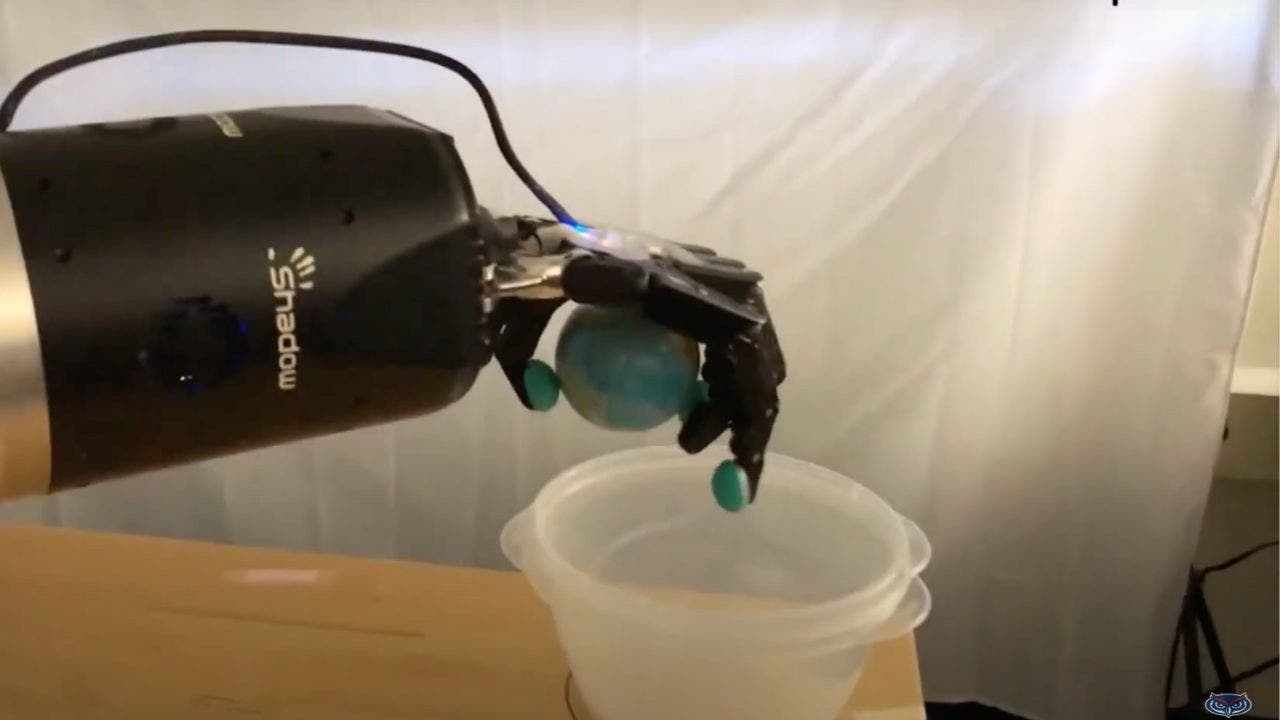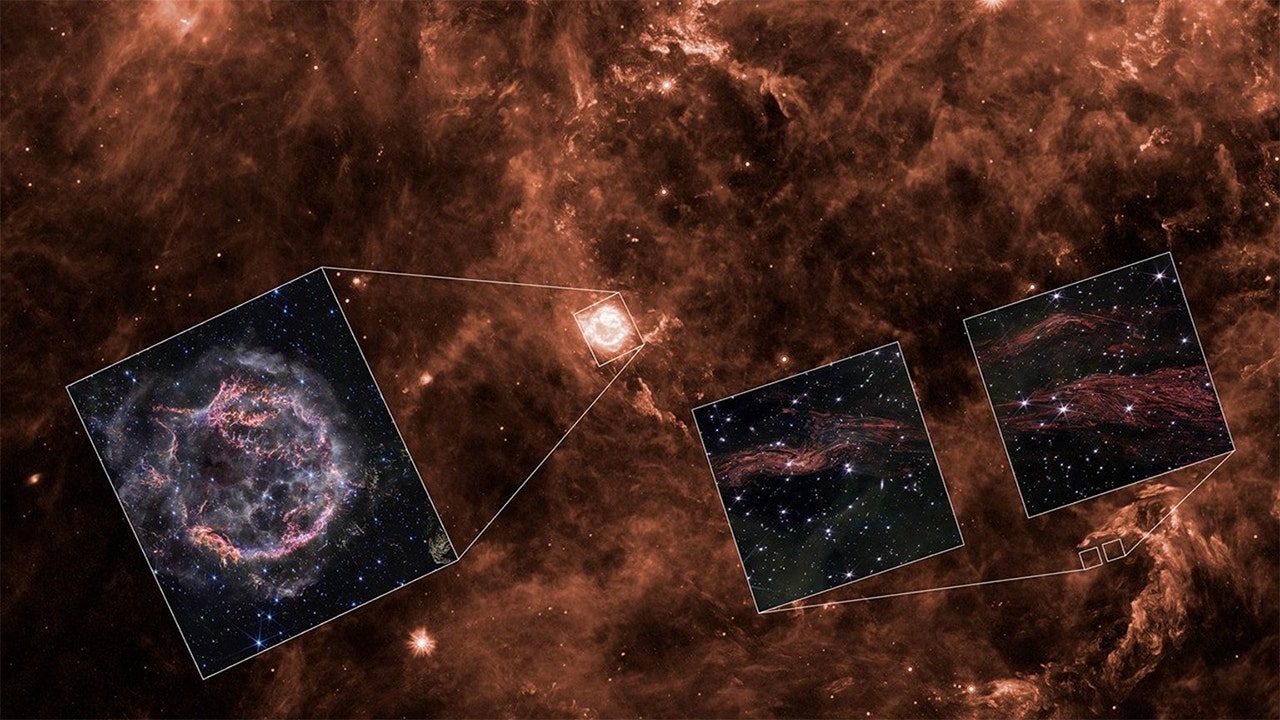Technology
Soft robotic armband gives prosthetic hand users natural control

Prosthetic hands have long struggled to replicate the dexterity and functionality of natural hands, often limiting users to a single grasp function at a time.
This limitation has made everyday tasks, such as typing on a keyboard or braiding hair, challenging for those who rely on prosthetics.
However, a groundbreaking study from Florida Atlantic University (FAU) offers promising advancements that could transform the experience of prosthetic hand users.
I’M GIVING AWAY THE LATEST & GREATEST AIRPODS PRO 2
Man sporting wearable soft robotic armband (Florida Atlantic University)
New technology enables users to grasp two objects at once
Researchers at FAU’s College of Engineering and Computer Science, in collaboration with the Charles E. Schmidt College of Science, conducted an innovative study that combined haptic feedback, electromyogram control and a wearable soft robotic armband. This study aimed to investigate whether users could control grip forces applied to two different objects simultaneously with a dexterous artificial hand.
WHAT IS ARTIFICIAL INTELLIGENCE (AI)?
The study’s findings, published in Scientific Reports, demonstrated that multiple channels of haptic feedback allowed participants to successfully grasp and transport two objects at once without dropping them, even when visual feedback was obstructed.
For example, participants managed to pinch a card between their fingers while simultaneously unscrewing a water bottle lid or toggling a light switch with their little finger.

Prosthetic robot hand (Florida Atlantic University)
NEW PROSTHETICS RESTORE NATURAL MOVEMENT VIA NERVE CONNECTION
Multichannel soft robotic armband
A key innovation in this research was the development of a multichannel soft robotic armband designed to convey artificial sensations of touch. This armband included soft actuators that provided proportional contact force feedback and vibrotactile stimulators that alerted users if they were about to drop or break an object. The armband’s design allowed it to deliver haptic feedback at three critical points corresponding to the thumb, index and little fingers, effectively enhancing the user’s ability to control multiple objects simultaneously.
Participants in the study reported that haptic feedback was significantly more important than visual feedback, especially since visual cues often failed to indicate when an object was about to be lost. This insight underscores the necessity of integrating tactile sensations into prosthetic technology.

Prosthetic robot hand (Florida Atlantic University)
BREAKTHROUGH PROSTHETIC FINGERS REVOLUTIONIZE THE LIVES OF AMPUTEES
Implications for future prosthetic design
The implications of this study extend beyond immediate user benefits; they suggest a paradigm shift in how prosthetic hands could be controlled in the future. By enabling refined dexterous control through enhanced sensory feedback, this research opens new pathways for individuals with upper limb loss to engage in complex tasks traditionally deemed impossible with current prosthetics. This includes activities such as playing musical instruments or performing intricate surgical procedures.
In addition, the researchers noted that participants with limb loss performed as well as able-bodied subjects in key performance metrics during the tasks. This finding is particularly encouraging for clinical applications and indicates that advancements in technology can bridge gaps in functionality for users.
SUBSCRIBE TO KURT’S YOUTUBE CHANNEL FOR QUICK VIDEO TIPS ON HOW TO WORK ALL OF YOUR TECH DEVICES

Prosthetic robot hand (Florida Atlantic University)
COULD THESE EXOSKELETON ‘POWERED PANTS’ MAKE OUTDOOR ACTIVITIES EASIER IN THE FUTURE?
Kurt’s key takeaways
As researchers continue to refine these prosthetic technology systems, we may soon see prosthetic hands that not only replicate but exceed the capabilities of natural hands, empowering users to reclaim their independence and engage fully in both everyday activities and specialized tasks. This innovative approach not only addresses existing limitations but also paves the way for future developments in assistive technologies for individuals with disabilities.
What personal experiences or stories do you have related to the use of prosthetics or assistive devices? Let us know by writing us at Cyberguy.com/Contact.
For more of my tech tips and security alerts, subscribe to my free CyberGuy Report Newsletter by heading to Cyberguy.com/Newsletter.
Ask Kurt a question or let us know what stories you’d like us to cover.
Follow Kurt on his social channels:
Answers to the most asked CyberGuy questions:
New from Kurt:
Copyright 2025 CyberGuy.com. All rights reserved.

Technology
Nintendo teases a new Mario Kart for the Switch 2
/cdn.vox-cdn.com/uploads/chorus_asset/file/25833774/image__1_.png)
/
More than a decade later, Mario Kart 8 appears to be getting a proper sequel.
Technology
LG Display announces its brightest, most striking OLED TV panel yet
/cdn.vox-cdn.com/uploads/chorus_asset/file/25833258/Screenshot_2025_01_15_at_8.11.01_PM.png)
The new panel’s innovation centers on a Primary RGB Tandem structure, which is LG Display’s proprietary technology that uses independent stacks of RGB elements to produce light. It had previously used a three-stack light source, with two layers of blue elements emitting relatively short energy wavelengths alongside red, green, and yellow elements in a single layer.
The Primary RGB Tandem structure applied to the fourth-generation OLED TV panel organizes the light source into four stacks by adding two layers of blue elements and independent layers of red and green elements. It improves maximum brightness by increasing the amount of light produced by each layer compared to the previous structure.
Technology
Powerful Webb Telescope captures photos of one of the earliest supernova ever seen

NASA’s James Webb Space Telescope (JWST) has captured photos of one of the earliest supernovas ever seen, with features appearing like grains and knots found in a cut of wood.
“Once upon a time, the core of a massive star collapsed, creating a shockwave that blasted outward, ripping the star apart as it went,” NASA said on its website. “When the shockwave reached the star’s surface, it punched through, generating a brief, intense pulse of X-rays and ultraviolet light that traveled outward into the surrounding space.”
Now, nearly 350 years later, scientists are getting a view of the aftermath as the pulse of light reaches interstellar material and causes it to glow.
The infrared glow created was captured by JWST, revealing details that look like knots and whorls found in wood grain.
POWERFUL WEBB TELESCOPE CAPTURES MOST DISTANT KNOWN GALAXY, SCIENTISTS SAY
This background image of the region around supernova remnant Cassiopeia A was released by NASA’s Spitzer Space Telescope in 2008. By taking multiple images of this region over three years with Spitzer, researchers were able to examine a number of light echoes. Now, NASA’s James Webb Space Telescope has imaged some of these light echoes in much greater detail. Insets at lower right show one epoch of Webb observations, while the inset at left shows a Webb image of the central supernova remnant released in 2023. (Spitzer Image: NASA/JPL-Caltech/Y. Kim (Univ. of Arizona/Univ. of Chicago). Cassiopeia A Inset: NASA, ESA, CSA, STScI, Danny Milisavljevic (Purdue University), Ilse De Looze (UGent), Tea Temim (Princeton University). Light Echoes Inset: NASA, ESA, CSA, STScI, J. Jencson (Caltech/IPAC).)
“Even as a star dies, its light endures—echoing across the cosmos. It’s been an extraordinary three years since we launched NASA’s James Webb Space Telescope. Every image, every discovery, shows a portrait not only of the majesty of the universe but the power of the NASA team and the promise of international partnerships. This groundbreaking mission, NASA’s largest international space science collaboration, is a true testament to NASA’s ingenuity, teamwork, and pursuit of excellence,” NASA Administrator Bill Nelson said. “What a privilege it has been to oversee this monumental effort, shaped by the tireless dedication of thousands of scientists and engineers around the globe. This latest image beautifully captures the lasting legacy of Webb—a keyhole into the past and a mission that will inspire generations to come.”
While beautiful in nature, the observations also give astronomers the ability to map the 3-dimensional structure of the interstellar dust and gas for the first time.
“We were pretty shocked to see this level of detail,” Jacob Jencson of Caltech/IPAC in Pasadena, the principal investigator of the science program, said.
Josh Peek of the Space Telescope Science Institute in Baltimore is also a member of the team and said they see layers like those of an onion.
POWERFUL WEBB TELESCOPE SPIES SPECTACULAR STAR BIRTH CLUSTER BEYOND THE MILKY WAY

These shimmering cosmic curtains show interstellar gas and dust that has been heated by the flashbulb explosion of a long-ago supernova. (NASA, ESA, CSA, STScI, J. Jencson (Caltech/IPAC))
“We think every dense, dusty region that we see, and most of the ones we don’t see, look like this on the inside,” he said. “We just have never been able to look inside them before.”
The images produced from the JWST near-infrared camera (NIRCam) highlight a phenomenon called light echo, NASA said, which is created when a star explodes or erupts before flashing light into surrounding masses of dust and causing them to shine.
The visible light echoes are caused when the light reflects off interstellar material, where those at infrared wavelengths are caused when the dust is warmed by energetic radiation, causing it to glow.
Scientists targeted a light echo previously observed by NASA’s retired Spitzer Space Telescope, and it is one of dozens found near remains of the Cassiopeia A supernova.
MERGER OF MASSIVE BLACK HOLES FROM EARLY UNIVERSE UNCOVERED BY WEBB TELESCOPE, SCIENTISTS SAY

FILE – In this April 13, 2017 photo provided by NASA, technicians lift the mirror of the James Webb Space Telescope using a crane at the Goddard Space Flight Center in Greenbelt, Md. (Laura Betz/NASA via AP, File)
The Webb images show tightly packed sheets, with filaments displaying structures on what NASA called “remarkably small scales,” of about 400 astronomical units, or less than one-hundredth of a light year. One astronomical unit is the average distance between the Earth and the Sun, and Neptune’s orbit is 60 astronomical units in diameter.
“We did not know that the interstellar medium had structures on that small of a scale, let alone that it was sheet-like,” Peek said.
The discovery was compared by scientists to a medical CT scan.
“We have three slices taken at three different times, which will allow us to study the true 3D structure. It will completely change the way we study the interstellar medium,” Armin Rest of the Space Telescope Science Institute, and member of the team, said.
The team’s findings will be presented this week at the 245th American Astronomical Society meeting in Washington, D.C.
The Webb Telescope, the successor to the Hubble and the largest telescope ever launched into space, is a joint project of NASA and the European Space Agency.
-
/cdn.vox-cdn.com/uploads/chorus_asset/file/25822586/STK169_ZUCKERBERG_MAGA_STKS491_CVIRGINIA_A.jpg)
/cdn.vox-cdn.com/uploads/chorus_asset/file/25822586/STK169_ZUCKERBERG_MAGA_STKS491_CVIRGINIA_A.jpg) Technology1 week ago
Technology1 week agoMeta is highlighting a splintering global approach to online speech
-

 Science5 days ago
Science5 days agoMetro will offer free rides in L.A. through Sunday due to fires
-
/cdn.vox-cdn.com/uploads/chorus_asset/file/25821992/videoframe_720397.png)
/cdn.vox-cdn.com/uploads/chorus_asset/file/25821992/videoframe_720397.png) Technology1 week ago
Technology1 week agoLas Vegas police release ChatGPT logs from the suspect in the Cybertruck explosion
-

 Movie Reviews1 week ago
Movie Reviews1 week ago‘How to Make Millions Before Grandma Dies’ Review: Thai Oscar Entry Is a Disarmingly Sentimental Tear-Jerker
-

 Health1 week ago
Health1 week agoMichael J. Fox honored with Presidential Medal of Freedom for Parkinson’s research efforts
-

 Movie Reviews1 week ago
Movie Reviews1 week agoMovie Review: Millennials try to buy-in or opt-out of the “American Meltdown”
-

 News1 week ago
News1 week agoPhotos: Pacific Palisades Wildfire Engulfs Homes in an L.A. Neighborhood
-

 Business1 week ago
Business1 week agoMeta Drops Rules Protecting LGBTQ Community as Part of Content Moderation Overhaul















